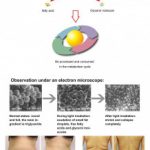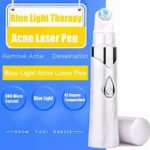LED light therapy is a popular treatment for skin-related problems like acne and aging signs. It has gained immense popularity due to its non-invasive nature and effectiveness. However, many individuals are curious about how this therapy works. In this article, we will explore the science behind the effectiveness of LED light therapy and how it works to improve the appearance and health of the skin.
Contents
The Science Behind LED Light Therapy
LED light therapy, also known as photobiomodulation, is a non-invasive treatment that uses specific wavelengths of light to stimulate cellular processes and promote healing. The therapy works by delivering light energy to the body’s tissues, which triggers a series of cellular responses that help to reduce inflammation, increase blood flow, and promote tissue repair.
The Role of Wavelengths
LED light therapy uses different wavelengths of light to target specific cellular processes. Red light, for example, has a wavelength of 630-660 nanometers and is used to promote collagen production and reduce inflammation. Blue light, which has a wavelength of 405-420 nanometers, is used to kill bacteria and treat acne. Near-infrared light, with a wavelength of 800-880 nanometers, is used to penetrate deep into the body’s tissues and promote cellular repair.
How the Body Responds
When the body is exposed to LED light therapy, the light energy is absorbed by the mitochondria in the cells. The mitochondria then convert the light energy into ATP, which is the energy source that cells use to carry out their functions. This increase in ATP production helps to boost cellular metabolism, which can lead to improved tissue repair, reduced inflammation, and increased blood flow.
Benefits of LED Light Therapy
LED light therapy has a wide range of applications and can be used to treat a variety of conditions. Some of the most common benefits of LED light therapy include:
LED light therapy, also known as photobiomodulation, delivers light energy of specific wavelengths to the body’s tissues, triggering cellular responses that promote healing. Red, blue, and near-infrared light are used to target specific cellular processes, such as collagen production, bacteria-killing, and cellular repair. The therapy can be used to improve skin health, reduce pain and inflammation, promote wound healing, improve sports performance, and have mood-boosting effects. LED light therapy can be administered in a variety of ways, with the devices’ specific wavelengths and intensity affecting its effectiveness, and safety precautions should be taken. The frequency of treatment depends on the condition and its severity. Numerous research studies have proven its effectiveness in treating diverse conditions.
Skin Health
LED light therapy can be used to improve the appearance of the skin by promoting collagen production, reducing inflammation, and increasing blood flow. The therapy can be used to treat acne, reduce the appearance of fine lines and wrinkles, and improve skin texture and tone.
Pain Relief
LED light therapy has been shown to be effective in reducing pain and inflammation, particularly in conditions such as arthritis and fibromyalgia. The therapy can be used to reduce pain and improve range of motion, making it a popular treatment option for athletes and individuals with chronic pain.
Wound Healing
LED light therapy can be used to promote wound healing by increasing blood flow and promoting cellular repair. The therapy can be used to treat a variety of wounds, including surgical incisions, diabetic ulcers, and pressure sores.
How to Use LED Light Therapy
LED light therapy can be administered in a variety of ways, including through the use of handheld devices, light panels, and full-body beds. The therapy is typically administered in sessions lasting between 10-30 minutes, depending on the condition being treated.
Choosing a Device
When choosing a device for LED light therapy, it’s important to consider the specific wavelengths of light being used, as well as the intensity of the light. Devices that use a combination of red and near-infrared light are typically the most effective, as they can penetrate deep into the body’s tissues and promote cellular repair.
Safety Precautions
While LED light therapy is generally considered safe, there are some precautions that should be taken to ensure its effectiveness and safety. It’s important to avoid looking directly at the light source, as this can cause damage to the eyes. It’s also important to avoid using the therapy on areas of the body that are exposed to sunlight, as this can increase the risk of sunburn.
Research Studies
Numerous research studies have been conducted on the effectiveness of LED light therapy for a variety of conditions. One study published in the Journal of Clinical and Aesthetic Dermatology found that LED light therapy was effective in reducing the appearance of fine lines and wrinkles, as well as improving skin texture and tone. Another study published in the Journal of Cosmetic and Laser Therapy found that LED light therapy was effective in reducing pain and inflammation in patients with osteoarthritis.
Mood and Sleep
LED light therapy has also been shown to have mood-boosting effects, and can be used to treat conditions such as seasonal affective disorder (SAD). The therapy can also be used to improve sleep quality and duration.
Sports Performance
LED light therapy can be used to improve sports performance by reducing muscle fatigue and speeding up recovery time. The therapy can be used to treat a variety of sports-related injuries, including strains, sprains, and muscle soreness.
Frequency of Treatment
The frequency of LED light therapy treatments will depend on the condition being treated and the severity of the symptoms. Some conditions, such as acne, may require daily treatments, while others, such as chronic pain, may only require weekly treatments.
FAQs: How does LED light therapy work?
What is LED light therapy?
LED (Light Emitting Diode) light therapy is a non-invasive, pain-free, and relaxing treatment that uses specific wavelengths of light to help improve the skin’s appearance and promote healing. This therapy works by penetrating the skin’s surface and reaching the deeper layers, where it triggers the body’s natural repair mechanisms.
How does LED light therapy work on the skin?
The light therapy uses different visible and near-infrared light wavelengths to target specific skin concerns. When the light penetrates the skin, it triggers a range of cellular responses that promote healing, reduce inflammation, increase collagen production, and improve blood circulation. It can help to reduce the appearance of wrinkles, acne, and pigmentation, and improve the skin’s overall texture and tone.
What are the different colors of LED light therapy and how do they work?
The different colors of LED light therapy work on different skin issues. Red light is used to stimulate collagen production, reduce inflammation, increase blood flow, and promote cell regeneration. Blue light is used to kill acne-causing bacteria, reduce inflammation, and unclog pores. Green light is used to reduce hyperpigmentation, calm irritated skin, and improve overall skin tone. Yellow light is used to improve lymphatic flow, reduce redness, and soothe the skin.
Is LED light therapy safe?
Yes, LED light therapy is safe and non-invasive. It does not involve the use of chemicals, UV rays, or any other harmful substances. The therapy has been used in the medical profession for several years to treat skin conditions and heal wounds.
How long does an LED light therapy session take?
LED light therapy sessions can vary depending on the skin concern being treated. Typically, each session ranges from 20 to 30 minutes. However, some treatments can last up to 45 minutes.
How many LED light therapy sessions are required to see results?
The number of LED light therapy sessions needed to see results varies depending on the skin concern being addressed and the individual’s skin type. A series of treatments is usually recommended for best results, and the number of sessions can range from 4 to 12. It is best to consult a skincare professional for personalized advice on the number of sessions required.








